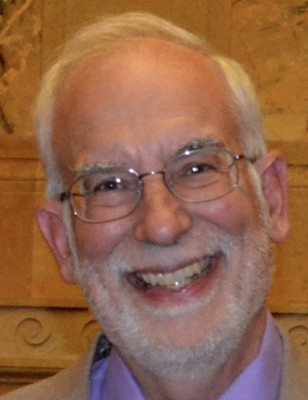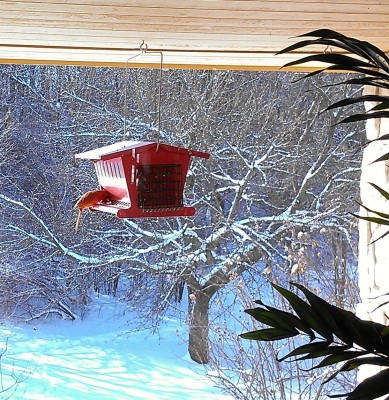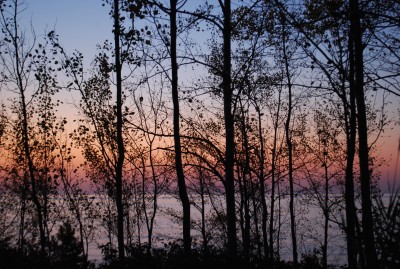Sacred spaces may have something to do with how we can use the coming season of Lent to draw ourselves a bit more into God’s presence and then let that experience shape how we live in the everyday spaces of our lives.
Today’s texts – Psalm 84 and Luke 2: 22-40

Where are the places you feel closest to God, where you feel God’s presence around you?
Take a few moments to think about that while I share a couple of images with you.
One of the places I feel closest to God is under a starlit sky, out in the country, sensing the vastness of the universe and sensing that somewhere within all of this is God’s creative energy.
Another place is here in this sanctuary – sometimes like this on a Sunday morning when the space is filled by people made in God’s image and God’s love is reflected through everyone gathered here; sometimes in an afternoon when the church is empty and I can sit on a chair and look out the windows to the beauty that surrounds this building.
How about for you? Where are some places where you feel closest to God?
(People offered replies during the service. If you have a sacred place you’d like to tell me about, please email me.)
I’m spending some time reflecting on sacred spaces today because I think they may have something to do with how we can use the coming season of Lent to draw ourselves a bit more into God’s presence and then let that experience shape how we live in the everyday spaces of our lives.
I love the imagery in Psalm 84 that we heard today. It is a wonderful set up for the power of sacred spaces.
How lovely is your dwelling place, O Lord of hosts! My soul longs, indeed it faints for the courts of the Lord; my heart and my flesh sing for joy to the living God.
This is one of several Psalms called “Psalms of Zion,” Psalms that stress the centrality of Jerusalem and the Temple in the Jewish tradition.
 This was the place that could put people in touch with God. This was where they found the sacred. And in Psalm 84, imagine a group of pilgrims on their way to the temple built by Solomon in Jerusalem.
This was the place that could put people in touch with God. This was where they found the sacred. And in Psalm 84, imagine a group of pilgrims on their way to the temple built by Solomon in Jerusalem.
As they come over a hill, they catch sight for the first time of this magnificent building.
How lovely is your dwelling place, O Lord of hosts!
And as the pilgrims approached the temple, their joy increased.
Even the sparrow finds a home, and the swallow a nest for herself, where she may lay her young, at your altars, O Lord of hosts, my King and my God. Happy are those who live in your house, ever singing your praise.
 God’s house embraces nature. God’s house becomes of home for some who actually live there, like the woman Anna we heard about in the Gospel story today.
God’s house embraces nature. God’s house becomes of home for some who actually live there, like the woman Anna we heard about in the Gospel story today.
This is the place to be. As the Psalmist says:
For a day in your courts is better than a thousand elsewhere. I would rather be a doorkeeper in the house of my God than live in the tents of wickedness.
For Judaism in the era of the Psalms, the Temple was indeed the place where they encountered God. It was only later, after they were driven into exile in Babylon and the temple was destroyed, that they began to sense that God was in the collection of sacred writings that they compiled, that God could be in the times of prayer that they had together, that sacred spaces took on new meaning.
When they returned to Jerusalem, they eventually rebuilt the temple, but they also built synagogues where they could gather to learn about God and begin to sense God’s presence in these smaller gatherings.
Remember Jesus getting up to preach in the synagogues in Nazareth and Capernaum?
But the Temple still held a central place in Jewish life. It was a sacred place unlike other.
We too have buildings that can pull us toward the magnificence of God.
Think of the cathedral at Notre Dame.

Think of the Sistine Chapel.

Think of the National Cathedral.

Spaces do not need to be grand to touch the sacred.

At the United Church of Christ national offices in Cleveland, there is a worship space known as the Amistad Chapel, named after the slave ship where the slaves who rebelled were imprisoned once the ship reached shore and where some of our UCC forebears led the successful legal battles for their freedom. This more intimate sacred space is designed to reflect the feeling of a ship and to reflect a commitment to justice.
Some spaces have more personal meaning – what may be a sacred space to me may not be the same for you.
 When I was a student at the University of Wisconsin in the late 1960s and early 1970s, my spiritual home was St. Paul’s University Catholic Center on State Street.
When I was a student at the University of Wisconsin in the late 1960s and early 1970s, my spiritual home was St. Paul’s University Catholic Center on State Street.
It’s a stark sort of place, but one of memories is sitting on the platform in the sanctuary playing the guitar during a weekly peace vigil. So Ellen and I went back there a few weeks ago for what would be the last Mass there before the building is torn down. That visit brought back memories of the time when that was my sacred space.
For many folks, the church where they were baptized or where they were married or where a loved one was buried evokes a special sense of the sacred.
These are all very public sacred spaces, of course. I’ll get to ways we might create our more personal sacred spaces in a moment. But I’d like to spend a few minutes with the Gospel reading from today, because it carries on that theme of significant things happening within these grand sacred spaces.
Once again, we are heading to Jerusalem to see the temple. This time, we are traveling with Mary and Joseph and their new baby, whom they have named Jesus.
According to Jewish law, the mother of a first-born son was considered unclean for about 40 days after the boy’s birth. Then she had to go to the temple – the sacred place – and bring an offering. The standard offering was a young lamb and a bird. But if you were poor, two birds would suffice.
One of the messages of Luke is that Jesus was from a poor family. Another is that Jesus was raised according to Jewish – that will be important later when he goes beyond the common understandings of that Law.
 What matters for today, though, is that his family went to the most sacred space in the most sacred city. This was the second Jewish temple, the one built long after the exile. It would last until about 70 A.D. when the Romans would destroy the temple and drive the Jews into a new diaspora – a new scattering across the known world.
What matters for today, though, is that his family went to the most sacred space in the most sacred city. This was the second Jewish temple, the one built long after the exile. It would last until about 70 A.D. when the Romans would destroy the temple and drive the Jews into a new diaspora – a new scattering across the known world.
They now once again had to define their sacred spaces in new ways. Passover feasts and Sabbath services in the home – these became the sacred places in Judaism.
And for the early Christians, the sacred places were also gatherings in homes, sharing stories, songs and a meal that recalled Jesus’ last supper with his apostles.
But they had also learned from Jesus that there were other sacred places.
 This photo is from the Mount of the Beatitudes looking down at the Sea of Galilee and towards Capernaum. This was prayer territory for Jesus.
This photo is from the Mount of the Beatitudes looking down at the Sea of Galilee and towards Capernaum. This was prayer territory for Jesus.
His followers had heard about him going off alone to pray in places like this. They had heard about how he connected with God in a boat in a storm or in a 40-day wilderness adventure or at a river as he was baptized or in a garden as he faced death. They had heard him speak about God’s Spirit filling their lives.
This brings us closer to the way we find sacred spaces in our lives beyond the confines of a building like this. This invites us to be intentional about defining what those spaces are and then using them in ways that can deepen our spirituality.
As we enter the season of Lent, one of the emphases we are going to have here at Memorial is on prayer. Now I fully embrace the idea that prayer can happen any where, any time. It can be while driving the car or in the shower or while on a walk or while doing dishes.
I think, however, there is a place between our gathering together as a community for prayer on Sunday mornings and those prayers-on-the move moments. I think Lent offers us a chance to pick a space and pick a time for a bit more intentional and individual prayer.
Think about how the Muslims in our world set aside time for prayer five times a day. They look for a quiet space, they have a series of physical actions. They start standing, then bow, then prostrate themselves on the ground or floor, and then conclude while sitting on the ground. During each posture, the worshiper recites or reads certain verses, phrases and prayers.
I’m not suggesting that for us. But I am suggesting that setting aside a specific time during Lent and being conscious of where we are can be part of our ritual of prayer.
In a few weeks, Ellen Reuter and Mary Ircink are going to be leading sessions on Tuesday evening exploring meditation, mindfulness, centering prayer – things that allow us to deepen our spirituality.
 But you don’t need to wait until then to find your sacred space and your sacred time. You can use short Bible readings or the UCC Lenten booklet that’s in the niche or some of the Lenten prayer resources we will have linked from our website in the next few days. Or you can create your own.
But you don’t need to wait until then to find your sacred space and your sacred time. You can use short Bible readings or the UCC Lenten booklet that’s in the niche or some of the Lenten prayer resources we will have linked from our website in the next few days. Or you can create your own.
As I draw to a close, let me take you back to the more public sacred spaces. Those personal places of prayer that we stake out for the most part tend to be peaceful places, I suspect. That picture of the Sea of Galilee, this picture of a sunrise over Lake Superior are so wonderfully mellow.
But sacred spaces can also be contested places.
Remember that for the Jews, both the first and the second temples were destroyed. Remember how conquering armies often destroy the sacred places of the lands they conquer, whether the smashing of statues and images by the Protestant reformers in the 1500s or the destruction of the magnificent stone Buddhas of Bamiyan in Afghanistan in the 1990s or the destroying of Shia Muslim mosques and shrines by ISIS in the past year.

Probably nowhere on earth is sacred space more contested than in Jerusalem. When the pilgrims of Psalm 84 reached the top of the hill and saw the temple, they could sing “how lovely is your dwelling place” with no competition.
Now the Western Wall of that Second Jewish temple abuts the Temple Mount where two of the most sacred Muslims shrine stand. And two-and-a-half miles away – a 15-minute walk – is the Christian Church of the Holy Sepulcher.
You know that the Temple Mount is a highly volatile space between Jews and Muslims. It is one of the flash points for uprisings.
The Western Wall itself is a hotly contested space. It was only in the past week that the Israeli government changed the rules so men and women could pray there together.
 And the Christian traditions that vie for control of the Church of the Holy Sepulcher are so bitterly divided that a Muslim family has entrusted with the keys to building since 1187.
And the Christian traditions that vie for control of the Church of the Holy Sepulcher are so bitterly divided that a Muslim family has entrusted with the keys to building since 1187.
So sacred spaces are not always peaceful places. Maybe that’s a reminder that in the midst of life’s conflicts, sensing God’s presence can be hard work.
When we get caught up in the conflicts of our community or family, of our beliefs or our politics, maybe the contested sacred places can remind us that this is not how it is supposed to be.
When we can join together in a shared space, we can let God’s presence embrace us and energize us. When we can find sacred spaces for ourselves, we can open our hearts to God’s love and open our minds to God’s words. We can renew our spirits and change the face of the earth.
Sacred places are powerful places. Let’s let them help shape our lives.
